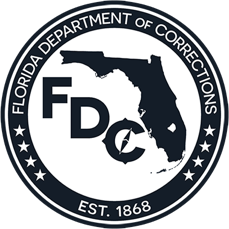1987
OFFENDER POPULATIONS JUNE 30, 1987:
INMATES: 32,764
SUPERVISED: 87,393
INMATES: 32,764
SUPERVISED: 87,393
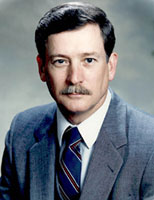
Richard L. Dugger,
Secretary
On January 1, 1987, Richard L. Dugger is appointed Secretary of the Department of Corrections by Governor Bob Martinez. He will remain in this position until May 9, 1991. Dugger is the first new Secretary of Corrections in a quarter century.
With the strong support of Governor Martinez, the Department of Corrections embarks on an unprecedented prison-building campaign to combat prison overcrowding exacerbated by skyrocketing admissions from the crack cocaine epidemic. He decides to use inmate labor to build the prisons, and land donated by counties in rural north Florida who welcome the state prison jobs. He also focuses on resolving the longstanding (and expensive) Costello lawsuit, which centered on prison overcrowding, food service and sanitation, and medical issues, and makes great strides toward resolving it. Just two months into the fiscal year, the inmate population had already exceeded the budgeted year-end population dramatically. Money for a total of 53,229 additional prison beds is appropriated over the next 10 years, beginning with a Special Session of the Legislature in 1987.
Click here to listen to Secretary Dugger tell about growing up on the prison grounds.
 Click here to hear Secretary Dugger tell the unusual story of how he decided where and how to build the new prisons.
Click here to hear Secretary Dugger tell the unusual story of how he decided where and how to build the new prisons.
 Click here to hear Secretary Dugger discuss the 21-years-long Costello v Wainwright Case.
Click here to hear Secretary Dugger discuss the 21-years-long Costello v Wainwright Case.
 Click here to hear Secretary Dugger discuss the flaws.
Click here to hear Secretary Dugger discuss the flaws.
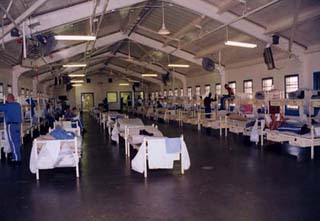
Many of the new prisons had open bay dormitories designed to house the maximum number of inmates in beds and bunkbeds with the fewest number of correctional officers. The layout was designed so that officers could see the entire area from the Control Room.
A special session of the Legislature appropriates funds for 1,133 new prison beds. During regular Legislative session (FY 87-88) 4,158 beds and 286 new positions for probation and parole services are appropriated.
Competitive area differential pay is implemented for the more expensive South Florida area, providing a $3,600 annual salary supplement for staff in this area.
Administrative Gaintime is implemented in February in an effort to prevent the prison population from exceeding the Court-ordered capacity limits of the Costello (lawsuit by inmate Michael V. Costello) agreement.
ADMINISTRATIVE GAINTIME
Daily, FDC staff in the Bureau of Admission and Release, under the able direction of Bobbie Glover, would have to maintain a tightrope-like balance between the Court-mandated number of inmates allowed to be in prison and the number who were actually there (which changed daily due to new admissions and releases), and the Department had no control over the date inmates were delivered from the counties. The Department had to "project" admissions on a daily basis, and release the difference if the anticipated number was over the Costello limits. Administrative Gaintime lasted from February 1987 to June 1988, then morphed into Provisional Release Credits from July 1988 to January 1991, and later Control Release (under administration of the Parole Commission) from January 1991 to December 1994. In each iteration, the requirements of those who could be released became more stringent and restrictive.
Almost all inmates were already getting one-third of their sentences reduced when they came into prison (Basic Gaintime), and they could earn a certain amount of time off their sentences for working, going to school and general good behavior (Incentive Gaintime). Administrative Gaintime was in addition to these other types of gaintime inmates were earning, so the amount of time served by inmates eligible for these early release credits began a downward spiral and was at an all time low by the early 90's.
In addition to Bobbie Glover, the following employees played a vital role in the incredibly complicated, exacting process of implementing administrative gaintime: Trisha Redd, Doyle Kemp, Buddy Ferguson, Cheryl Dula, Linda Santana, Electra Pacchioli, and the late, great Rob Sommers. It's interesting to note that all most all of these employees remained with the Department for their entire careers except for Rob, who died much too young but is remembered fondly.
Putnam Correctional Institution (Palatka, FL) is dedicated on May 8, 1987
While Putnam C.I. opened in 1984, it was not dedicated until 1987. This may have been due to the ongoing renovations to the buildings since the infrastructure was slowly converted from a road prison (East Palatka Road Prison) to a correctional institution. Click here to see a program from the Putnam CI dedication ceremony on May 8, 1987.
Officer Fred S. Griffis, along with an armed escort officer, are taking an inmate to a doctor's appointment outside the prison grounds. They are jumped by two males armed with handguns. They disarm the officer, and Officer Griffis refuses to give up the keys to unlock the van to free an inmate. He tosses the keys away and is shot and killed by the suspects in West Palm Beach on June 24, 1987. Officer Griffis was employed at Glades Correctional Institution. The shooters are Frank Valdez and William Van Poyck, both of whom are sentenced to death.
Frank Valdez is later killed in prison and three corrections officers are tried for his murder, and acquitted, as was another employee prior to this trial.
William Van Poyck is executed on June 12, 2013, after 25 years on death row.
FROM AN ARTICLE IN THE JULY 1987 CORRECTIONAL COMPASS
Correctional Officer I Fred S. Griffis, 40, was shot and killed June 24, 1987 during an unsuccessful escape attempt in West Palm Beach. Griffis and fellow Glades C.I. officer Steve Turner, 29, were transporting inmate James J. O'Brien to a doctor's office in West Palm Beach where police say they were ambushed by two armed men. Officer Griffis, who had the keys to the back of the van, threw them into some bushes in an effort to keep the inmate locked in the van. When Officer Griffis refused an order by one of the gunmen to free O'Brien, he was shot in the head and chest.
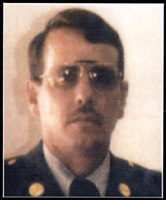
Officer Fred S. Griffis
The suspects then tried unsuccessfully to shoot the lock off the van, according to police. Turner was injured when a bullet ricocheted off the van and struck him in the shoulder.
Inmate O'Brien never left the van. Police said the two gunmen fired a number of rounds at them during a high-speed chase that ended when they ran their Cadillac into a palm tree. The two suspects, identified as William Van Poyck, 32, and Frank Valdez, 24, are in police custody.
Officer Griffis, a decorated Vietnam veteran, had recently retired from the U.S. Army after serving from April 1966 to June 1969, and from July 1970 to May 1987. He was decorated seven times for heroism during the war. Griffis had previously worked at Glades C.I. from 1969 to 1970 as a Correctional Officer. He returned to work there on June 9, 1987.
Department of Corrections Secretary Richard L. Dugger eulogized Officer Griffis during a memorial service June 27 in West Palm Beach, as did Army Sergeant David Mills, who worked with Griffis at the West Palm Beach Army recruiting office. Approximately 2,000 friends, relatives, correctional, county, and state agency personnel were in attendance, including Governor Bob Martinez and his wife, Mary Jane.
Officer Griffis was buried June 29 with military honors at a national cemetery in Homestead. Governor Martinez ordered all FDC facilities to fly their state and U.S. flags at half-staff through the completion of funeral services.
Memorial services were held at various institutions throughout Florida for those who wished to pay their respects but were unable to attend the service in West Palm Beach.
In Region IV, officers at Marion C.I. relieved Glades C.I. officers so they could attend the service.
The Florida Corrections Academy opens in Vero Beach for probation and parole officers, with a full curriculum providing 320 hours of basic recruit training and advanced training with provisions for salary increases upon completion.
Offender Based Information System (OBIS): New databases implemented this year include the Cost of Supervision (COS) System.
Hamilton Correctional Institution (Jasper, FL) opens. Sumter Boot Camp and Levy Forestry Camp are established. Butler Transit Unit renamed New River Correctional Institution.
Tents are removed.
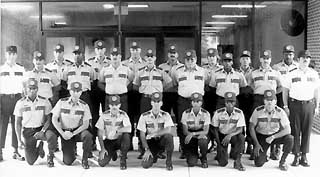
Sumter Boot Camp Staff -- bottom row: Sgt. Alvin Mitchell, Sgt. Terry Turner, Sgt. James Royals, CO Ray Andrews, CO Sheila Tribble, CO Anthony Daily, CO Ralph Kennedy; middle row: Lt. Jim Tridico, Sgt. William Love, CO Claude Dudley, CO Gary Stevenson, Sgt. Richard Hewett, Sgt. Raymond Kugler, CO Paul Tanner, CO Gary Leathers, Major Colchiski; top row: Sgt. John Baxter, CO Arthur Springer, CO Tom Hare, CO Marvin Ryan, CO Darlene Quesenberry, CO Kevin Gilbert, CO Michael Bellamy.
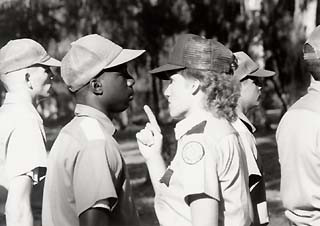
Sumter Boot Camp is a military-type basic training program for youthful offenders.

Sumter Boot Camp Obstacle Course

Sumter Boot Camp Gym
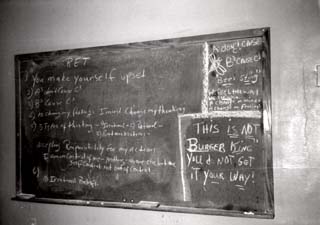
Sumter Boot Camp blackboard reads "This is not Burger King -- You do not get it your way"
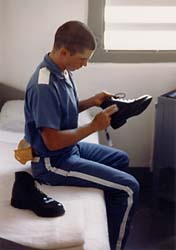
The daily regimen requires all inmates to press their clothing and "spit-shine" their shoes.
- 1821-1845
- 1868-1876
- 1877-1895
- 1900-1919
- 1921
- 1922-1924
- 1927
- 1928-1931
- 1932 | CHAPMAN
- 1933-1935
- 1936-1939
- 1940-1945
- 1946-1949
- 1950-1955
- 1956-1961
- 1962 | WAINWRIGHT
- 1963-1965
- 1966-1969
- 1970-1975
- 1976-1979
- 1980-1986
- 1987 | DUGGER
- 1988-1990
- 1991 | SINGLETARY
- 1992-1995
- 1996-1998
- 1999 | MOORE
- 2000-2002
- 2003 | CROSBY
- 2004-2005
- 2006 | MCDONOUGH
- 2007
- 2008 | MCNEIL
- 2009-2010
- 2011 | BUSS
- 2011 | TUCKER
- 2012 | CREWS
- 2013-2014
- 2014 | JONES
- 2015-2018
- 2019 | INCH
- 2020-2021
- 2021 | DIXON
- 2022-Today
- Population Summary Table


